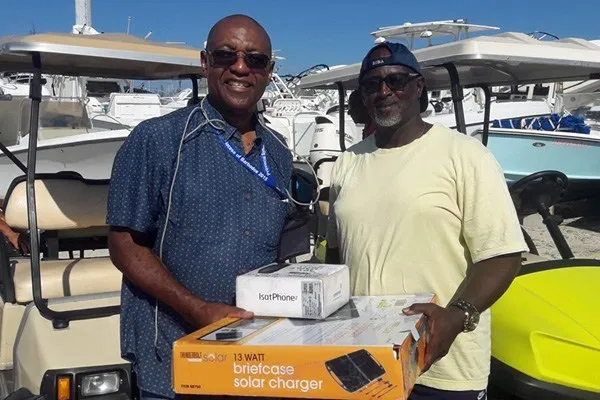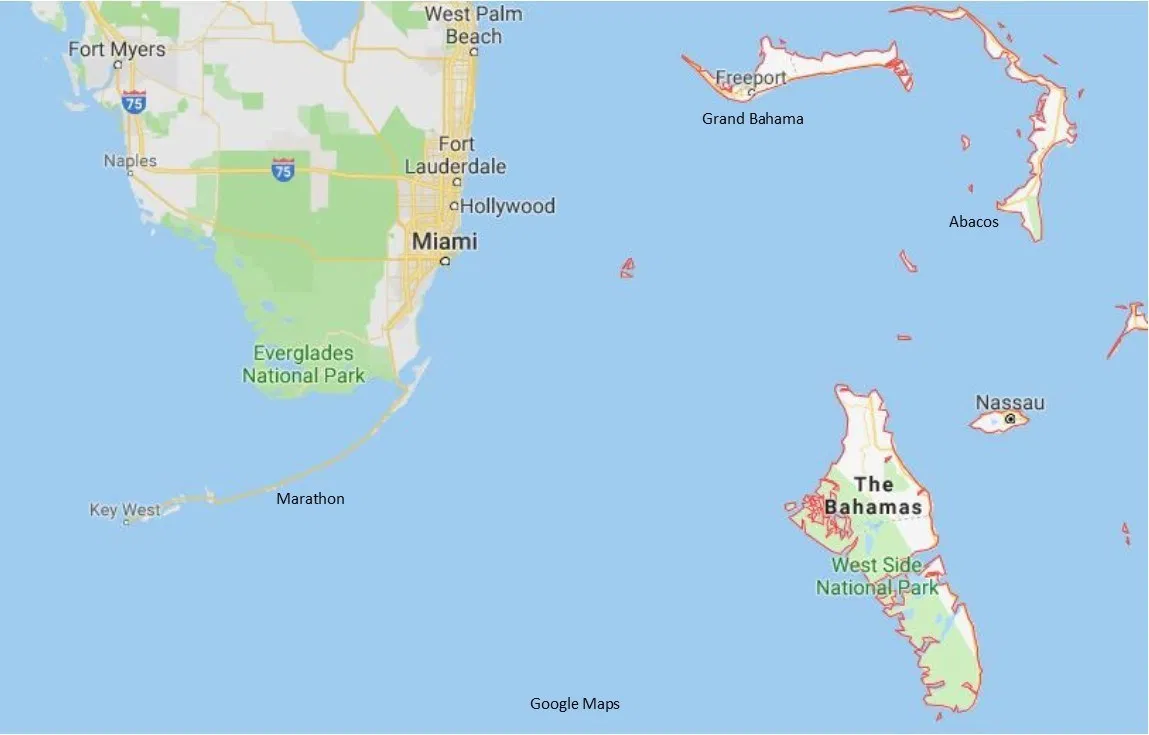Bahamas Bishop Laish Zane Boyd, above left, delivers a satellite phone to Joel Reckley of Saint Peter’s Anglican Church, Green Turtle Cay. SE Florida Bishop Peter Eaton flew from Miami to Nassau to deliver the phone.
When the Rt. Rev. Peter Eaton became the Bishop of Southeast Florida, he knew the job would involve leading a diocesan staff, ordaining new priests, and celebrating the Eucharist in every church in the diocese on a rotating basis. He didn’t know he’d be flying to a hurricane-ravaged country to deliver a satellite phone.
This is Eaton’s fourth hurricane season as head of the Miami-based diocese, and for the third year out of four he is appealing for funds for hurricane relief. Two years ago, much of the worst damage was in his own diocese, after Hurricane Irma took direct aim at the fragile Florida Keys.
This year, Hurricane Dorian largely spared the diocese – and the entire United States. But it struck Grand Bahama and the Abacos Islands as a Category 5 storm on September 1, and parked there for more than two days, causing catastrophic damage. At least 50 people were killed, probably many more, and 70,000 are homeless.
The Anglican Diocese of The Bahamas and The Turks and Caicos Islands is one of Southeast Florida’s companion dioceses, and many members of Eaton’s flock have strong ties to the island country and the rest of the Caribbean. Eaton himself spent much of his childhood in the Caribbean, as his father, a priest, taught at Codrington College in Barbados.
So this is personal.
On Friday, September 6, Eaton flew from Miami to Nassau, the largely undamaged Bahamian capital, which is separated by 90 miles of water to the southwest of the Abacos. He met there with the Rt. Rev. Laish Zane Boyd, whose diocese includes churches on islands scattered around a patch of ocean larger than the state of California.
“I went last Friday to take a satellite phone that is bound for Green Turtle Cay,” Eaton told TLC earlier this week. “A person that I know here in Florida has a lot of relationships in Green Turtle Cay … and he wanted them to have a satellite phone so that they could communicate.” Green Turtle Cay (pronounced “key”) is one of the dozens of islands of the Abacos.
also took the bishop a check with some funds we have begun to raise here,” he said. The bishop’s appeal for the Bahamas began while the storm was still doing its worst, and continues today. A parish in the diocese offered to match the first $50,000 raised in the appeal, and Eaton expects to disclose how much money has been raised later this week.
Eaton got on a flight home without leaving the Nassau airport, to avoid any disruption in the efforts to house and feed the refugees flooding into the city. He told Boyd, “I want to go with him when he’s able to enter the Abacos and Grand Bahama, so that I can be a support to him and see for myself and be a better witness for raising support here on the mainland.”
Episcopal Relief & Development has been coordinating efforts with several other dioceses through its U.S. Disaster Program, including Central Florida, South Carolina and Georgia. ER&D is also working with the Anglican Alliance, the relief & development agency of the Anglican Communion.
“Disasters have three phases: rescue, relief and recovery,” said Katie Mears, Senior Director for Episcopal Relief & Development’s US Disaster Program. In the Bahamas, people are still being rescued, and relief efforts will continue for months. Recovery will continue for years.
Eaton said the Florida Keys have not entirely recovered from Hurricane Irma, which plowed into the Keys on September 10, 2017. The Florida Keys are a string of islands connected by a single highway, stretching 113 miles west and south of the tip of the state, into the Gulf of Mexico.
The Rev. Canon Debra Maconaghey, rector of St. Columba’s in Marathon then and now, has been living with Irma every day for the past two years. Her church escaped serious damage, but the surrounding town was devastated. Marathon is roughly in the center of the Keys, midway between Key Largo and Key West.
“If you actually get off the Overseas Highway and go down the street, there are some streets that look like the hurricane hit yesterday,” she said.
Maconaghey estimated that the Keys as a whole has recovered from about 75% of Irma’s damage. “But keys that were the hardest hit? Probably 50%, or maybe even less than that,” she said. “We have people from our parish still living in trailers in their driveways.”
“You have the physical damage, and then you have the psychological damage. You see that is still very close to the surface,” she said, adding that some people felt a need to evacuate ahead of Dorian.
Since the storm, boats have been traveling back and forth from the Keys to the Bahamas with supplies, Maconaghey said. “The general world was so gracious to the Keys. It was a miracle, the amount of help we received. We felt loved, and thought-about, and cared-for,” she said. “We’ve tried to respond in kind to the Bahamas.”
DraggedImage.c21a4d4bf43241a29d6a80688c43da56.png
DraggedImage.0cb29ccd61f348db89155d81db11a908.png




